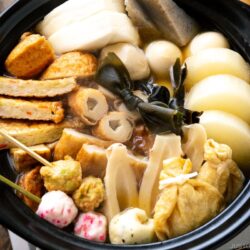
Oden (Japanese Fish Cake Stew)
Oden represents the best of wintertime food in Japan. This classic stew features an assortment of fish cakes simmered in a soy sauce-based dashi broth. Served family style in a donabe clay pot, it‘s a comforting dinner to share with family and friends when the weather turns cold.
Ingredients
For the Ingredients
- 4 inches daikon radish
- 1 package konnyaku (konjac) (9 oz, 255 g)
- 1 package oden set (assorted Japanese fish cakes and fish balls) (about 27 oz, 750 g)
- 1 package deep-fried firm tofu cutlet (atsuage) (6.5 oz, 184 g)
- 2 pieces aburaage (deep-fried tofu pouch) (optional; for the mochi kinchaku)
- 2 pieces Japanese rice cake (kiri mochi) (optional; for the mochi kinchaku)
- 4 hard-boiled eggs (boiled for 8 minutes, cooled, and peeled)
- 1 package hanpen (fish cake) (4.6 oz, 130 g)
- 4 pieces dried knotted kombu (or hydrate a large piece of kombu, cut strips, and tie a knot in each)
For the Broth
- 6 cups dashi (Japanese soup stock) (use standard Awase Dashi, dashi packet or powder, or Vegan Dashi; I highly recommend a strong dashi flavor for this recipe)
- 2 Tbsp usukuchi (light-colored) soy sauce (you can use regular soy sauce, but the broth will be darker)
- 1 Tbsp sake
- 2 Tbsp mirin
- ½ tsp Diamond Crystal kosher salt
For Serving
- Japanese karashi hot mustard (optional)
Instructions
- Gather all the ingredients. If you can‘t find dried knotted kombu, hydrate a large piece of kombu, cut it into individual strips, and tie a knot in each. If the hydrated kombu is very thick and not pliable, skip tying the knots and instead cut it into smaller strips or squares.
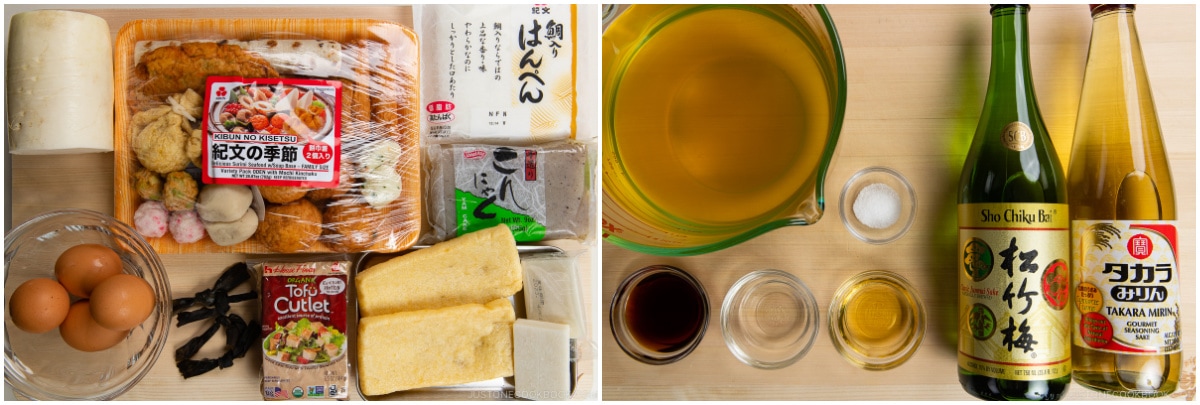
To Prepare the Daikon
- Using a vegetable peeler, remove the outer skin from 4 inches daikon radish. Then, slice the daikon into round pieces 1 inch (2.5 cm) thick.
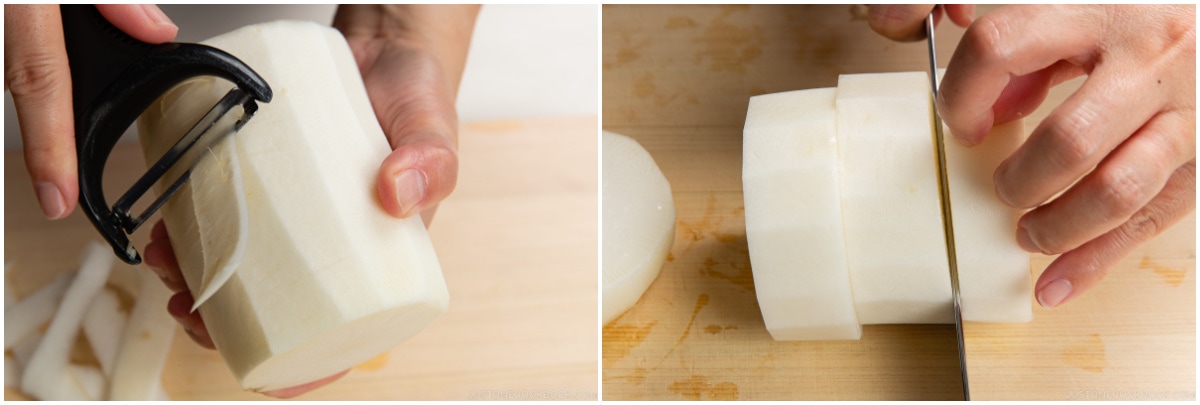
- With the knife, remove the sharp edges of the daikon slices to smooth them out. This technique is called mentori. The rounded corners and edges will prevent the daikon from breaking and protect its shape. Next, score a cross on one flat side of the daikon slices, about ¼ inch deep, so they will absorb more flavors.
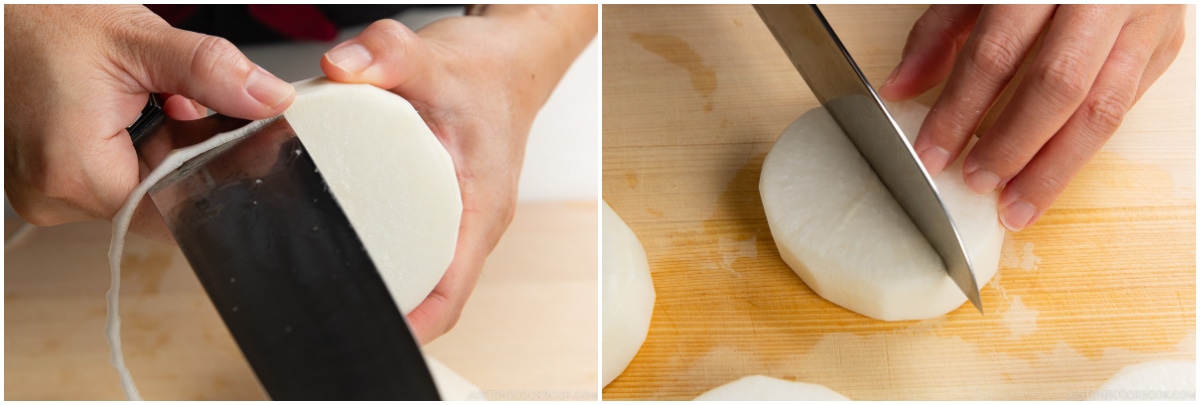
- If you are going to serve rice with the Oden, reserve the cloudy water from rinsing the rice. Fill a medium pot with this cold, cloudy water.
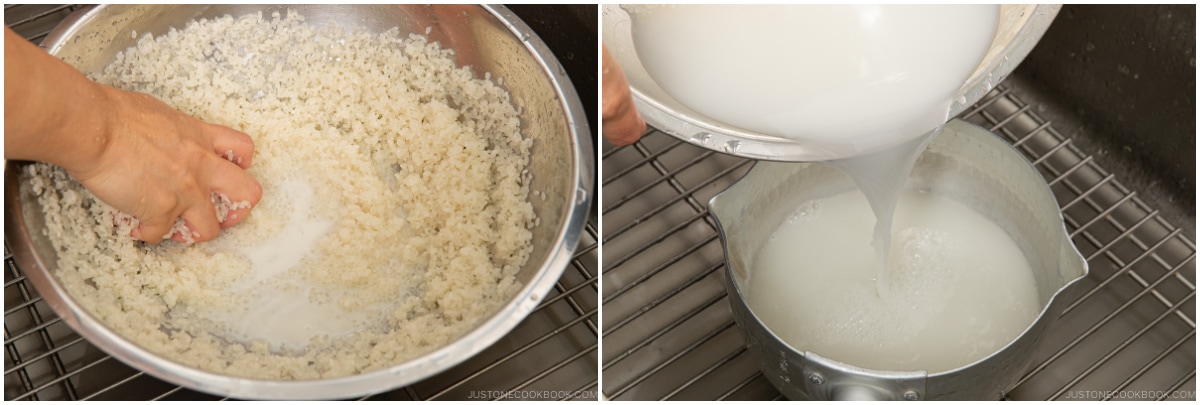
- Add the daikon to the pot. Turn on the stove to medium heat and cook, uncovered, for about 20 minutes. Drain and rinse the daikon in running water. Set aside. Tip: This method helps get rid of the daikon‘s bitterness and odor and makes the daikon a beautiful white color. Make sure to cook the daikon starting with cold water. This allows the center of the daikon to cook slowly before the water reaches a boil and that will help cook the daikon evenly.
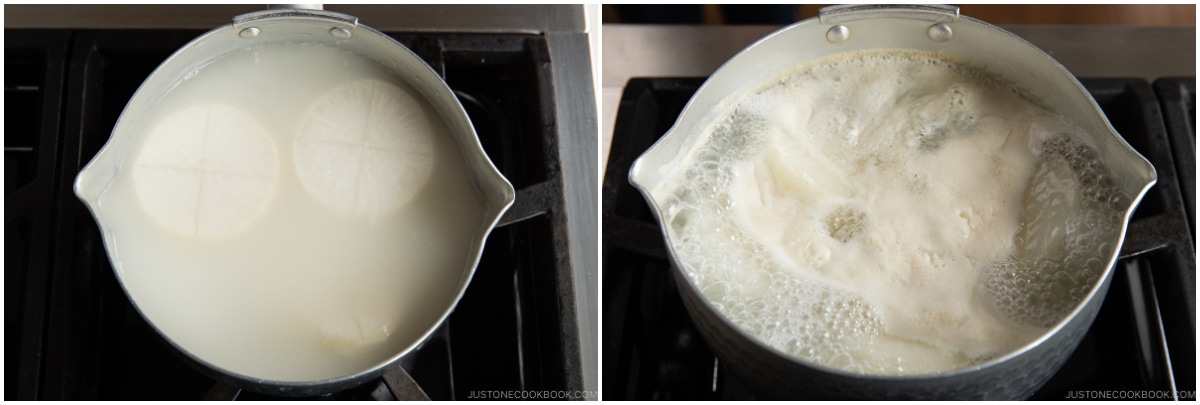
To Prepare the Konnyaku
- Bring a small saucepan of water to a boil. Meanwhile, score one side of 1 package konnyaku (konjac) in a crisscross pattern: Make diagonal cuts in one direction about ⅛ inch (3 mm) deep and ⅛ inch (3 mm) apart, then repeat the diagonal cuts in the other direction. Tip: This will help the konnyaku absorb more flavors.
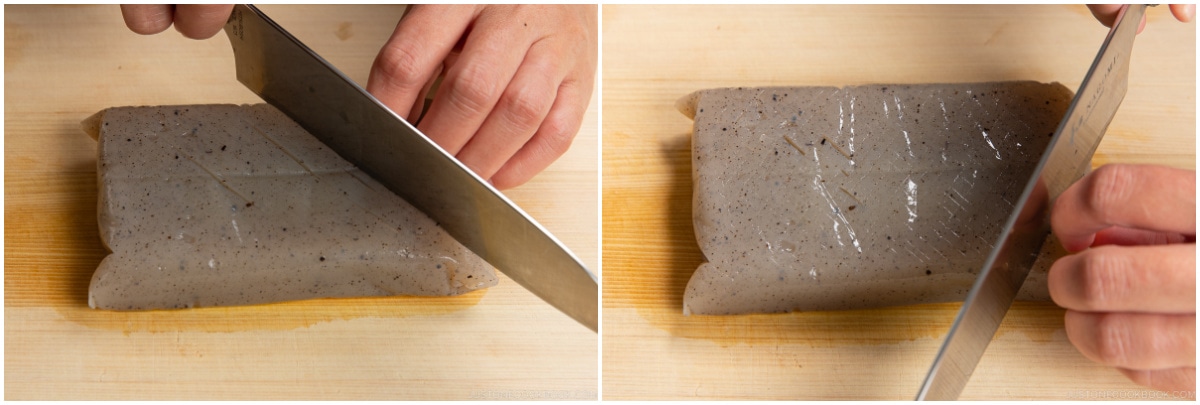
- Next, cut the konnyaku into thirds crosswise. Then, cut each third in half diagonally, creating a triangle shape.
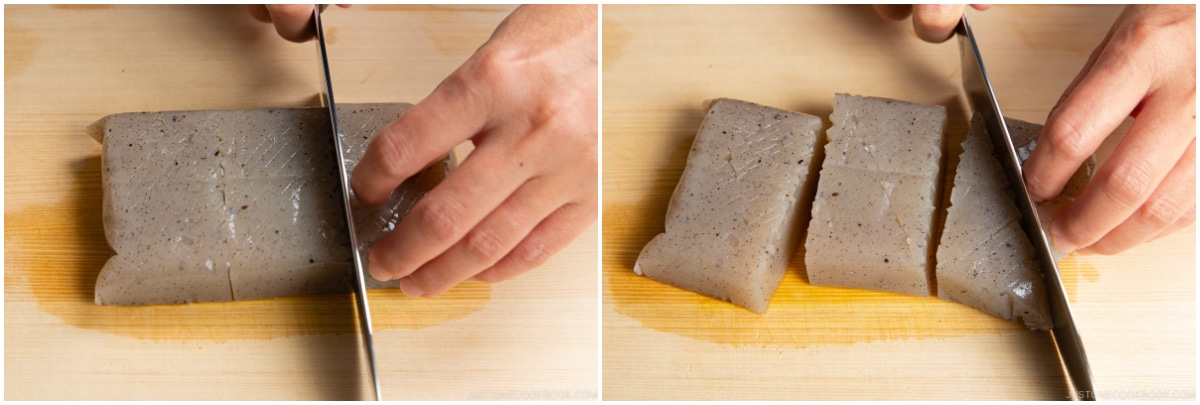
- Place the konnyaku in the boiling water, cook for 3 minutes, and drain. Tip: This helps to remove the odor from the konnyaku.
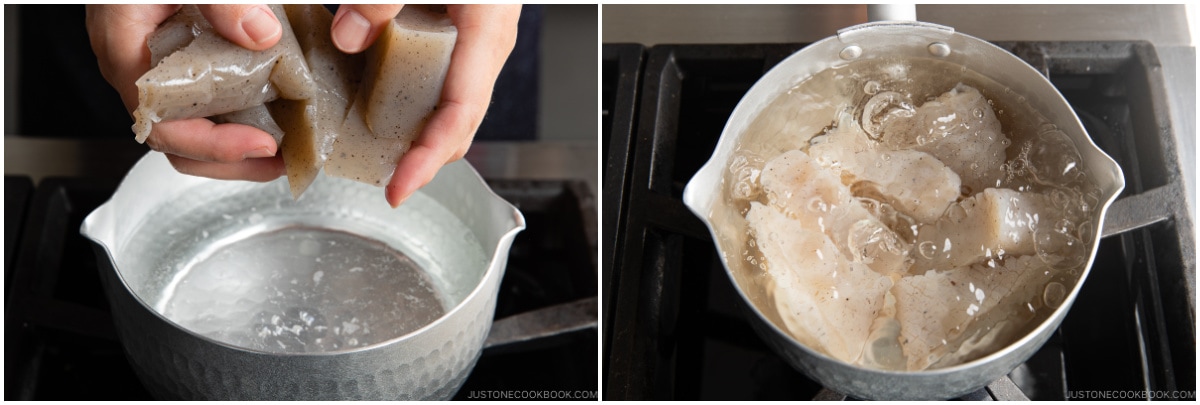
To Remove the Excess Oil from the Oden Set
- Put water in a donabe (Japanese clay pot) or a large, shallow pot and bring it to a boil. Add 1 package oden set (assorted Japanese fish cakes and fish balls)—we call them nerimono—to the boiling water for 15–30 seconds. Tip: This recommended step removes the excess deep-frying oil from factory processing.
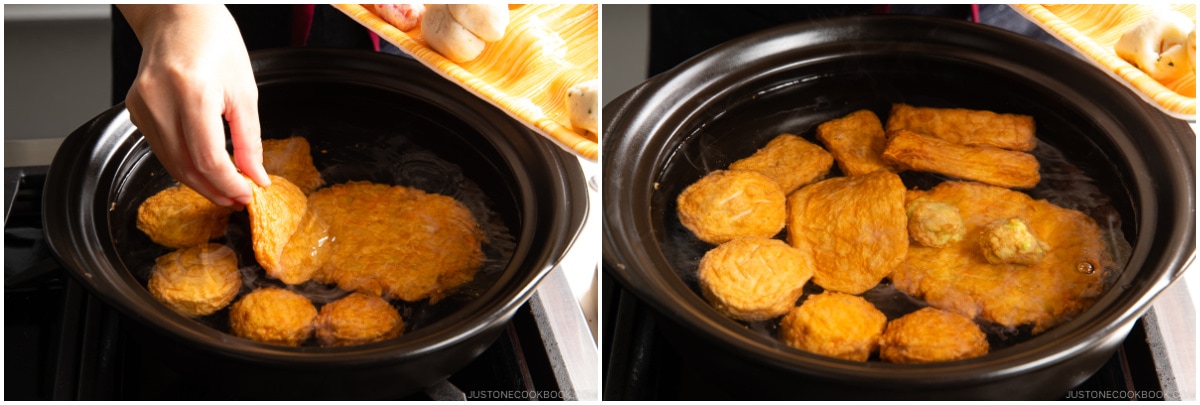
- Remove the fish cakes and fish balls from the boiling water and transfer them to a plate or tray. Let cool. Keep the boiling water in the pot, if you are going to make mochi kinchaku (optional). Otherwise, drain the water and rinse the pot.
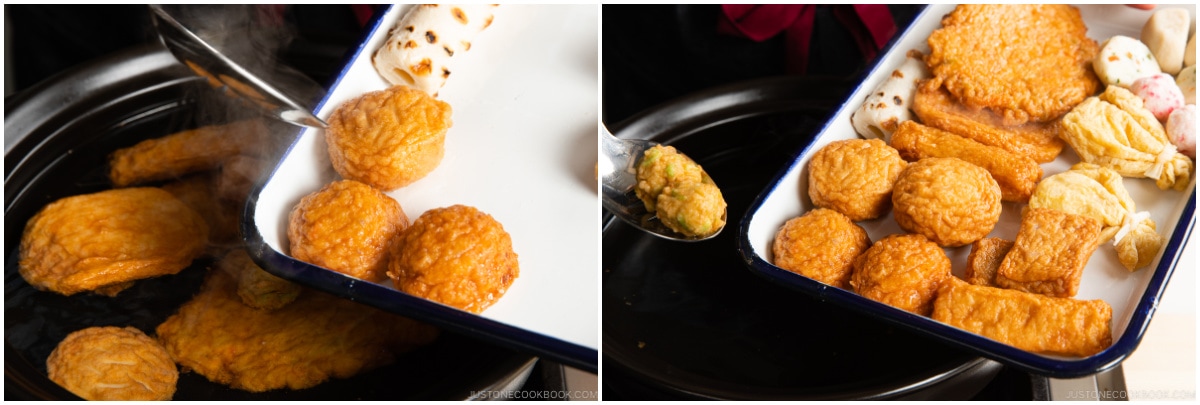
To Make the Mochi Kinchaku (optional)
- Blanch 2 pieces aburaage (deep-fried tofu pouch) in the reserved boiling water for 15–30 seconds to remove the excess oil. Remove them from the water and set aside. Drain the water and rinse the pot.
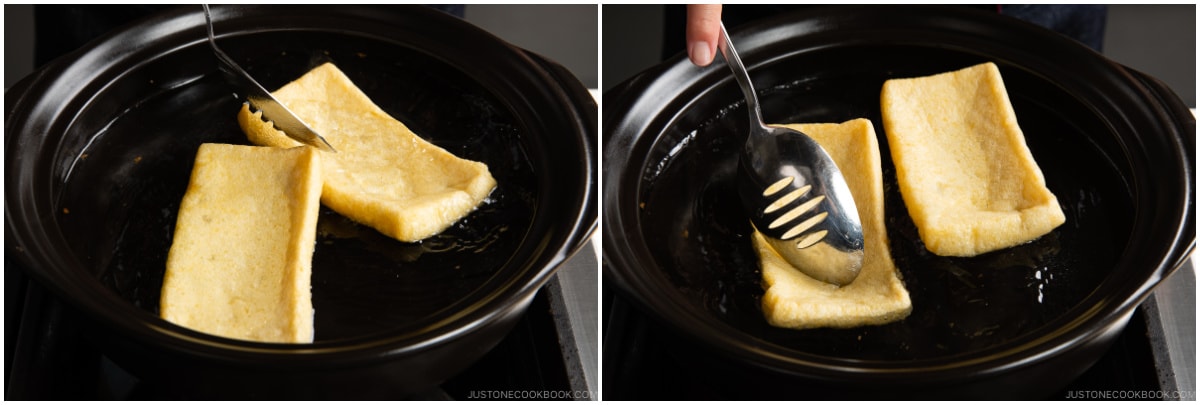
- Cut the aburaage in half crosswise to make two square pockets. Cut 2 pieces Japanese rice cake (kiri mochi)—also called kirimochi—in half or small enough to fit into the tofu pocket.
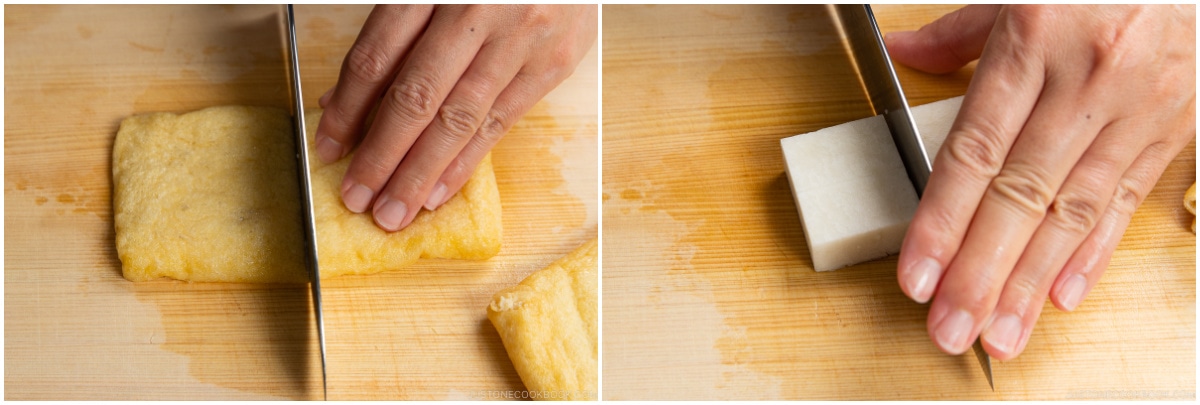
- Open one aburaage pocket and put a piece of kirimochi inside. Use a toothpick to close the aburaage pouch so the mochi doesn‘t fall out during cooking. Repeat to make the remaining pouches.
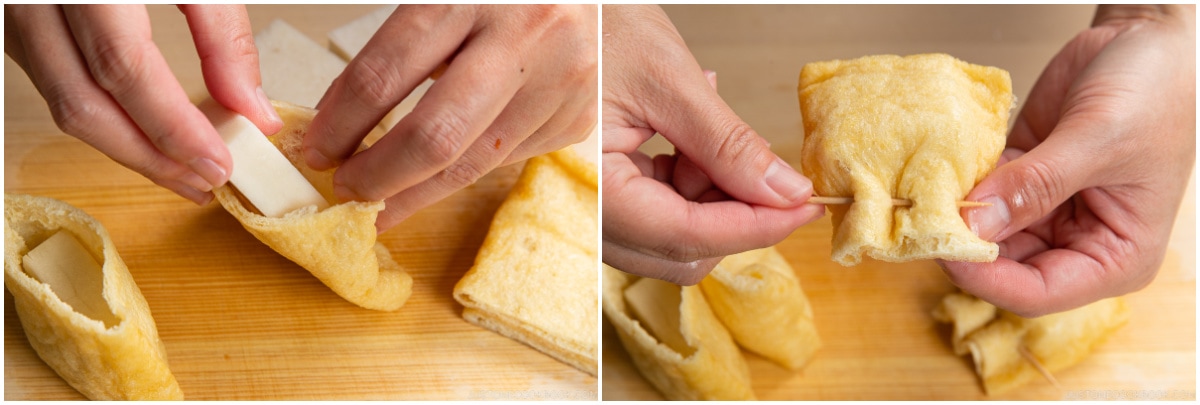
To Prepare the Broth
- To the rinsed donabe or large pot, add 6 cups dashi (Japanese soup stock), 2 Tbsp usukuchi (light-colored) soy sauce, 1 Tbsp sake, 2 Tbsp mirin, and ½ tsp Diamond Crystal kosher salt. Mix well together.
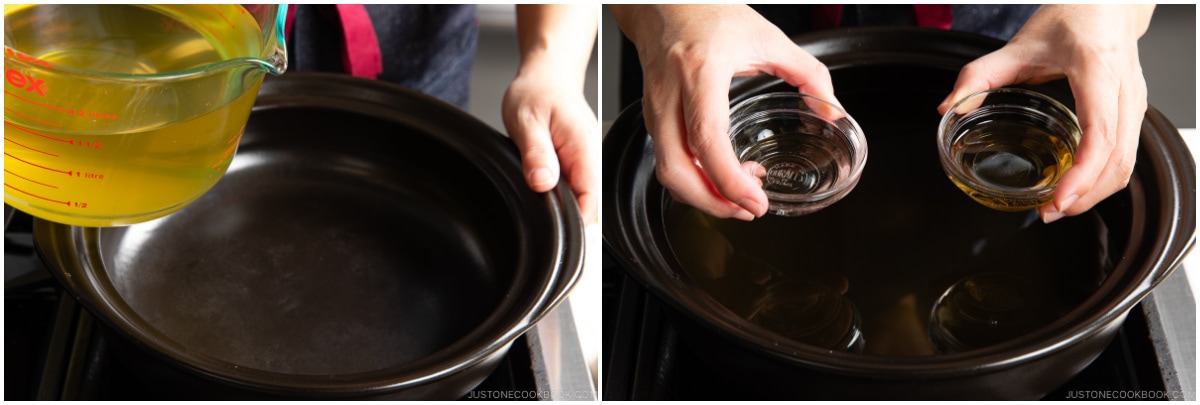
To Cook the Oden
- Put the daikon, konnyaku, and 4 hard-boiled eggs (peeled) in the donabe or pot. Bring it to a boil.
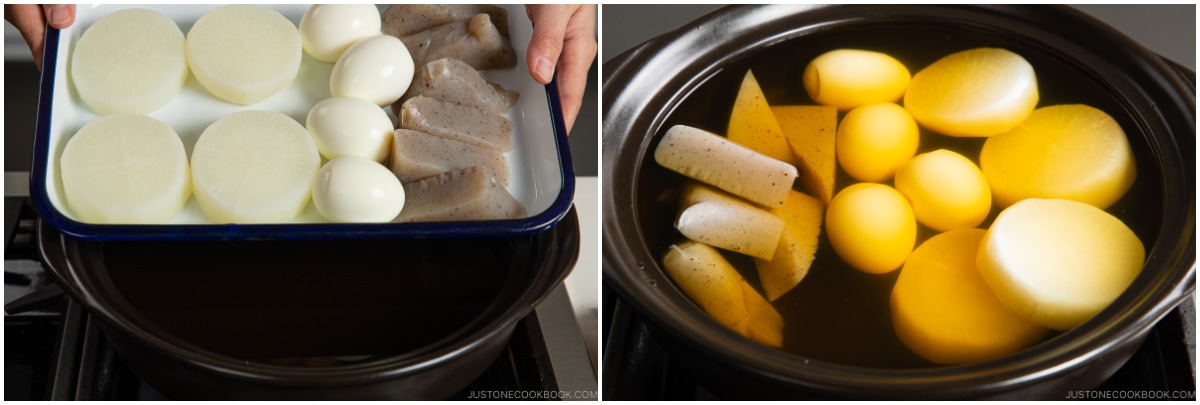
- Once boiling, reduce the heat to low or medium low to maintain a simmer. Cook, uncovered, for 20 minutes.
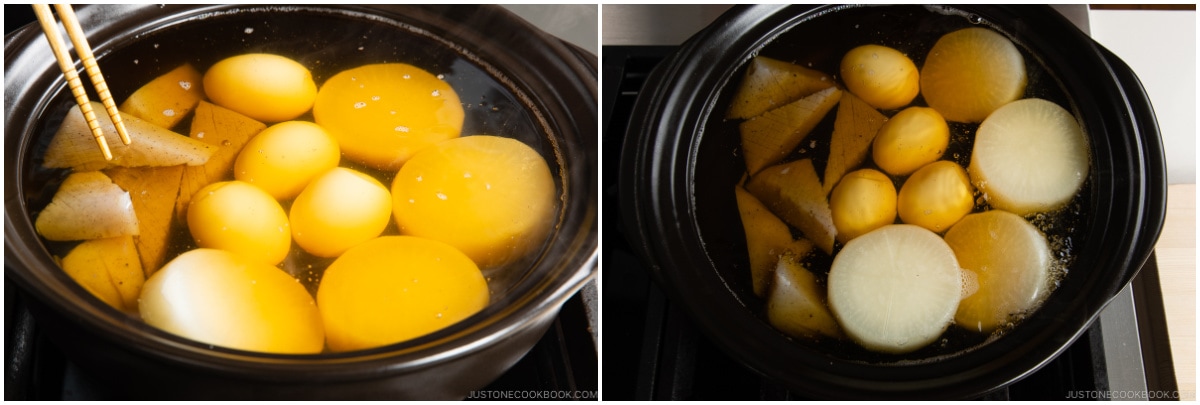
- Meanwhile, cut the big pieces of fish cakes in the oden set in half or quarters so they are a convenient size to pick up with chopsticks. Here, I cut the larger Satsuma age (round fried fish cakes) into quarters and the chikuwa (baked fish cakes) diagonally in half.
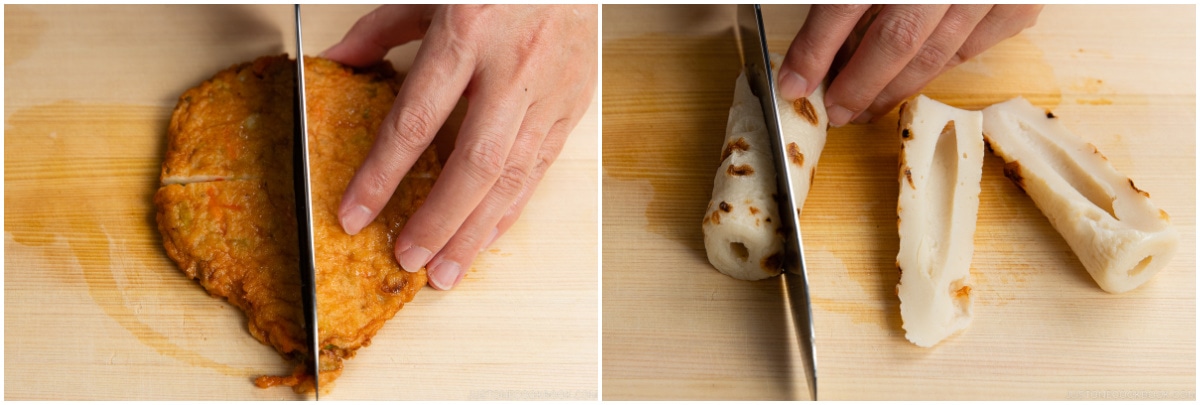
- I cut the gobo-maki (burdock fish cake rolls) and fish balls in half.
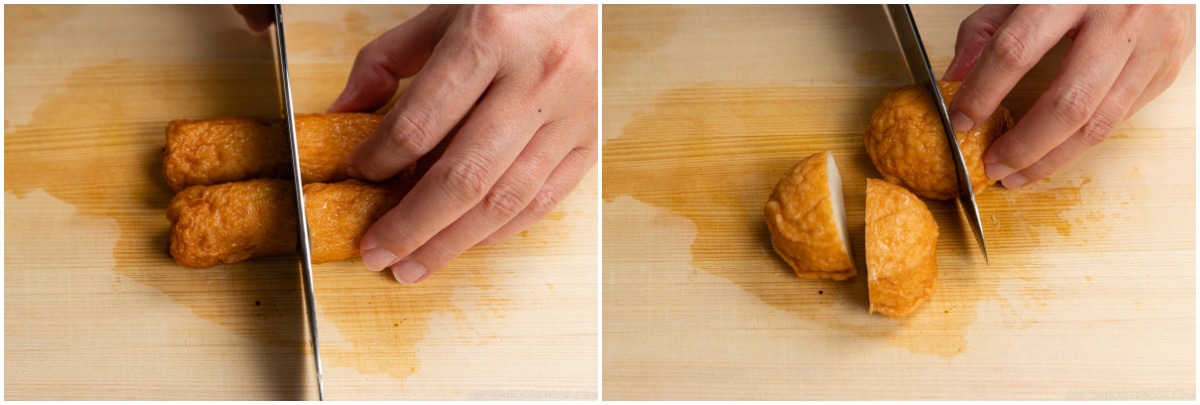
- I cut the medium-sized Satsuma age in half. I cut the pieces of 1 package deep-fried firm tofu cutlet (atsuage) in half crosswise and then cut each piece in half again diagonally.
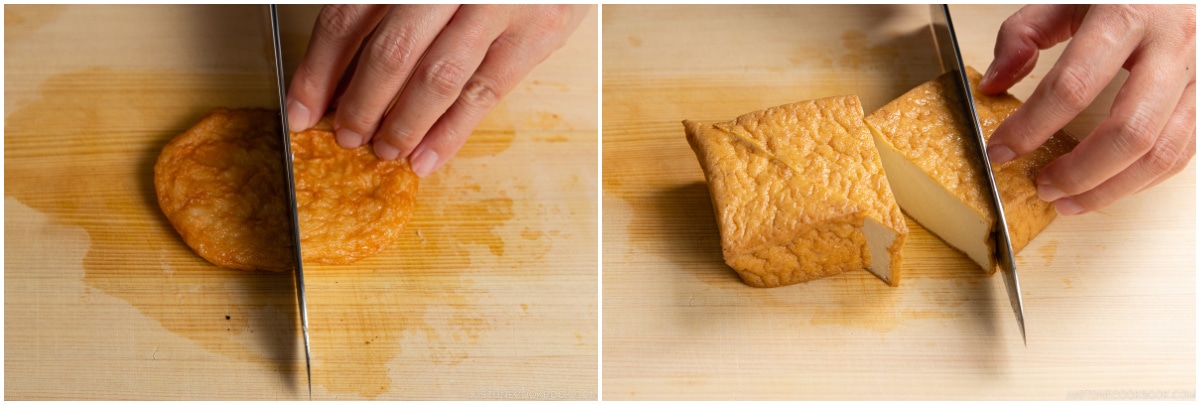
- For the small fish balls, you can thread two pieces onto a skewer to keep them together. Diagonally cut 1 package hanpen (fish cake) in quarters.
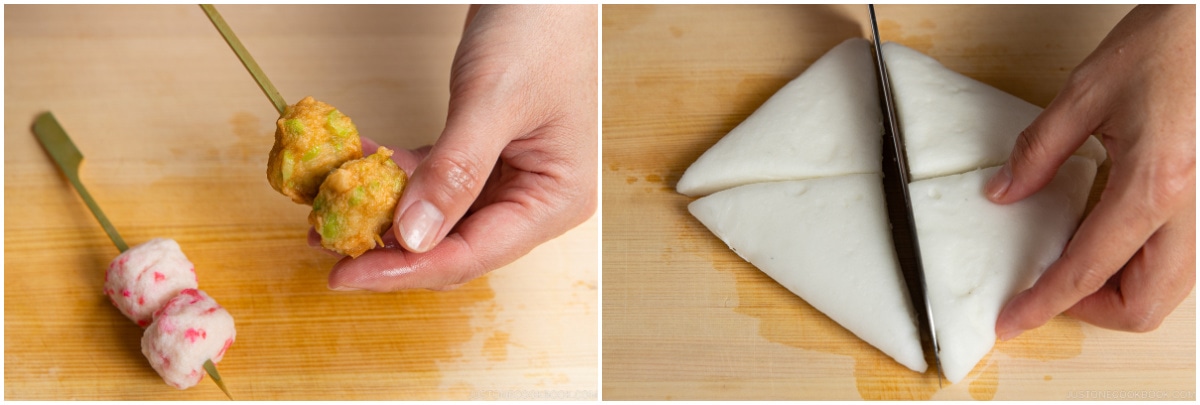
- After 20 minutes, check your oden pot. If there‘s so much broth that your oden pot will overflow when you add the oden set and other fish cakes, transfer some broth to a measuring cup (or bowl) and set aside. You can add this reserved broth to the pot later, as needed.
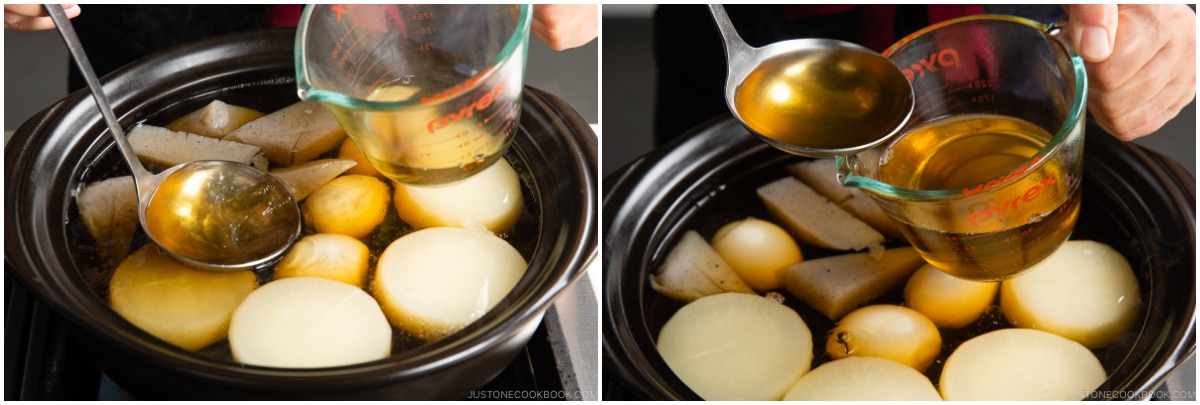
- Now, add the oden set, other fish cakes (except for the hanpen), atsuage, and 4 pieces dried knotted kombu to the pot. Cook for 10 minutes.
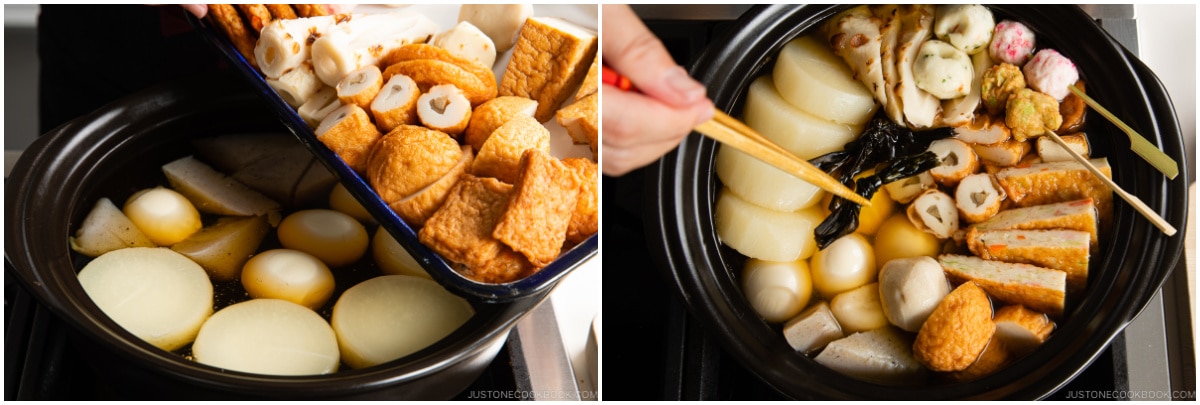
- After 10 minutes, add the hanpen and the mochi kinchaku (optional). Cook for 3 minutes. Now, your oden is ready to serve. Alternatively, you can turn off the heat and let it cool on the countertop. Tip: Just like other Japanese simmered foods (nimono), letting oden cool in the broth allows the flavors of the savory dashi to soak into the ingredients.
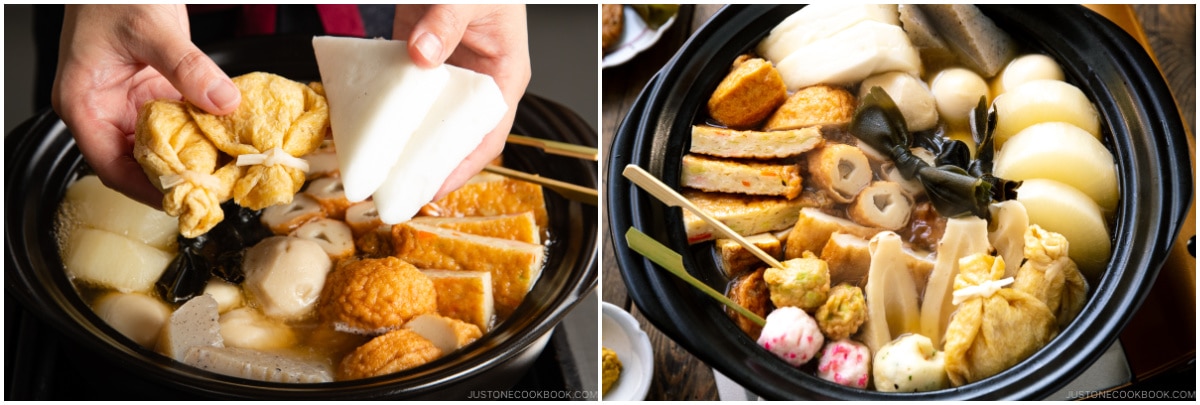
To Serve
- Serve hot. Reheat oden if you let it cool in the previous step, but make sure not to overcook it.
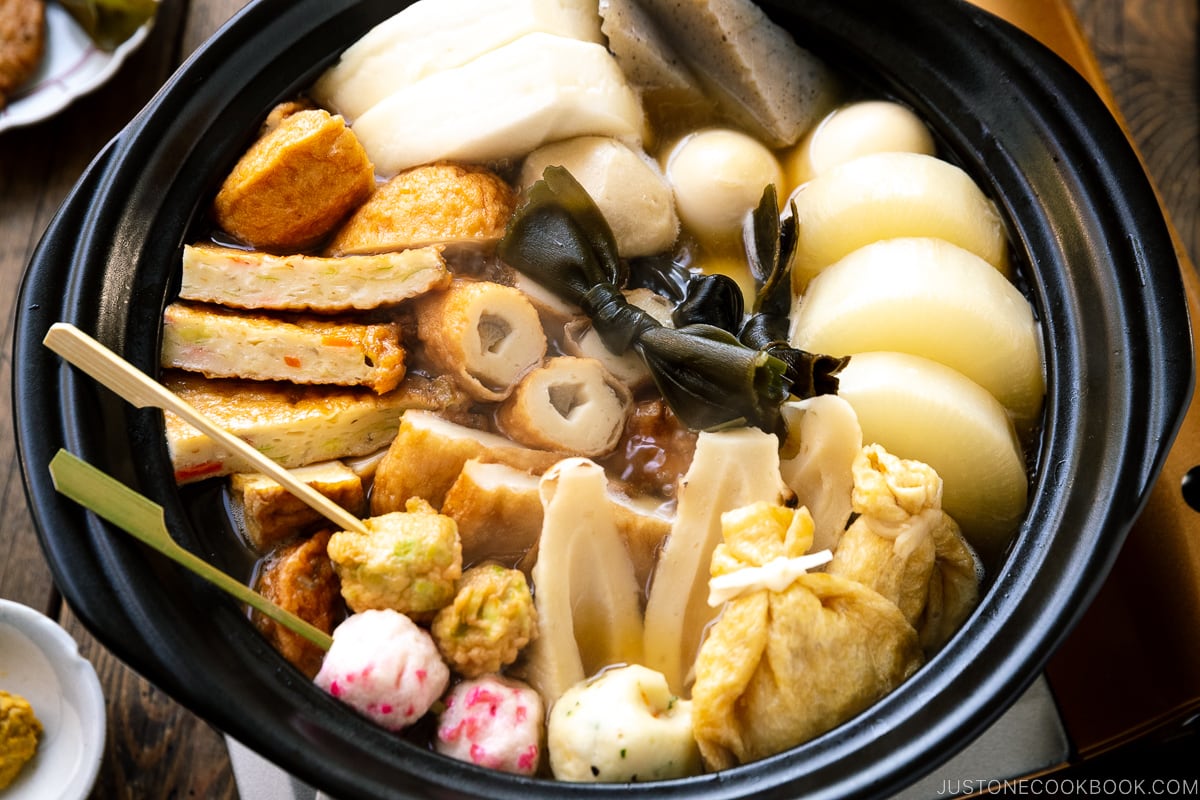
- Oden is usually served with a little bit of karashi (hot mustard) on the side. To make karashi, combine 2 tsp Japanese karashi hot mustard with 3 tsp (1 Tbsp) of hot water in a small bowl.
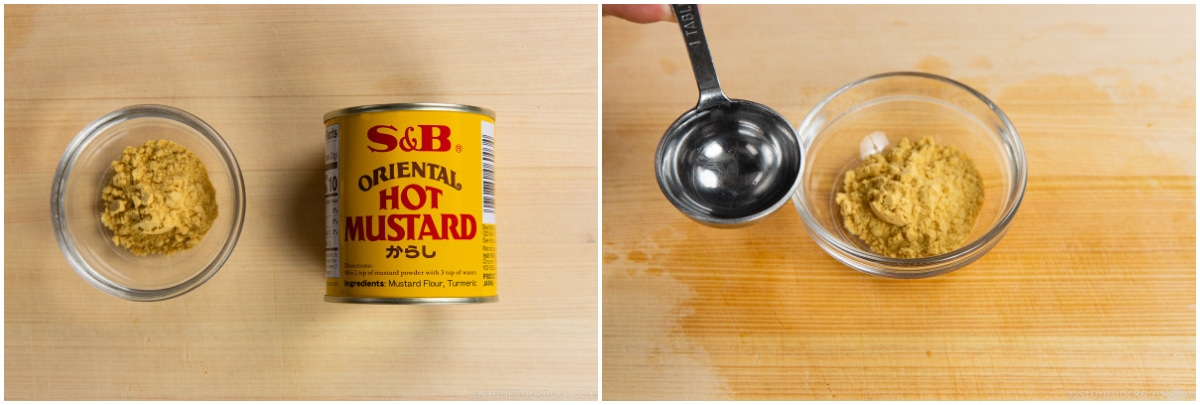
- Mix together, cover the bowl with plastic wrap, and flip upside down to let it steam under the bowl for 5 minutes to get a good taste and aroma. Unwrap the bowl and the karashi is ready to use.
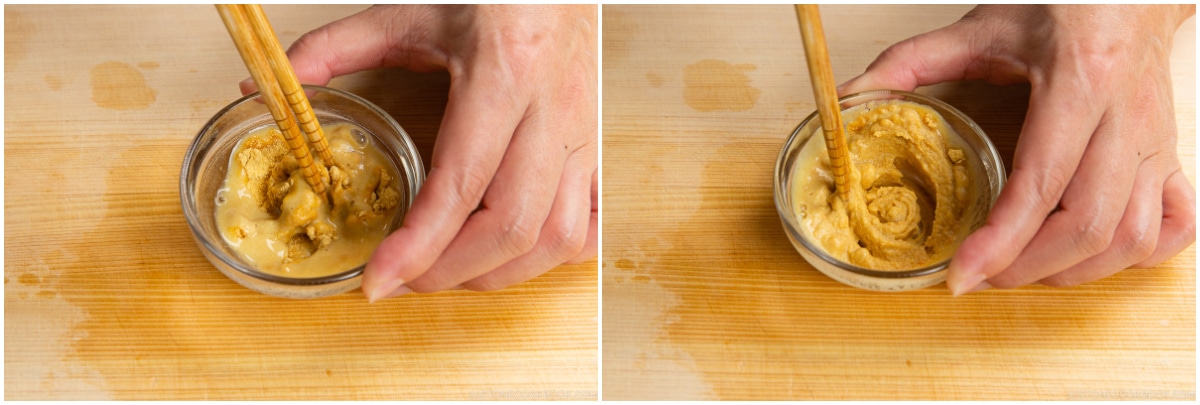
To Keep
- You can keep the leftovers in an airtight container and keep them for 3 days in the refrigerator or for up to a month in the freezer (do not freeze eggs and konnyaku). Reheat before serving, but do not overcook it.
Nutrition
Calories: 569kcal, Carbohydrates: 63g, Protein: 31g, Fat: 17g, Saturated Fat: 4g, Polyunsaturated Fat: 2g, Monounsaturated Fat: 3g, Cholesterol: 209mg, Sodium: 1249mg, Potassium: 401mg, Fiber: 6g, Sugar: 33g, Vitamin A: 260IU, Vitamin C: 15mg, Calcium: 238mg, Iron: 3mg